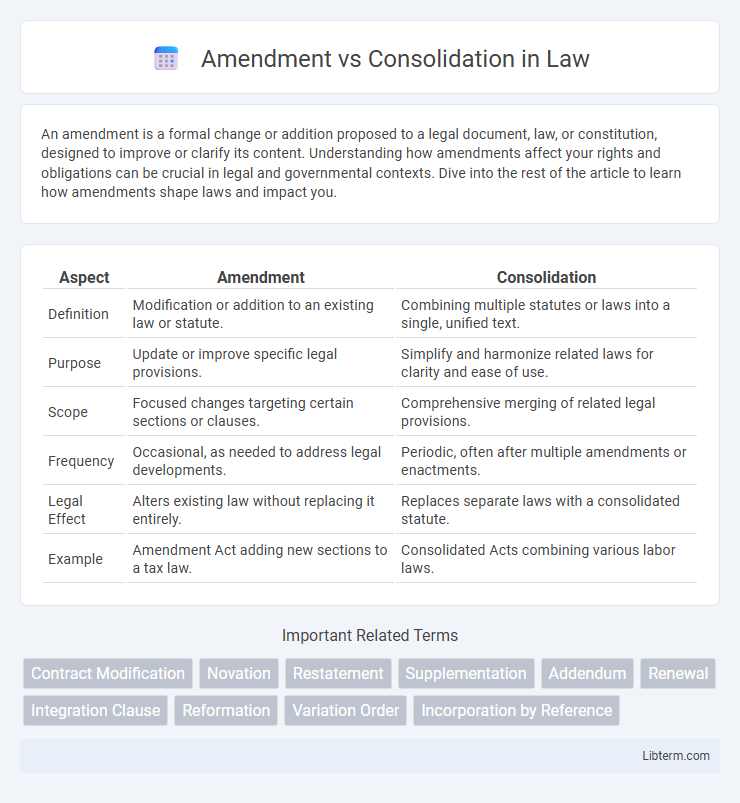An amendment is a formal change or addition proposed to a legal document, law, or constitution, designed to improve or clarify its content. Understanding how amendments affect your rights and obligations can be crucial in legal and governmental contexts. Dive into the rest of the article to learn how amendments shape laws and impact you.
Table of Comparison
| Aspect | Amendment | Consolidation |
|---|---|---|
| Definition | Modification or addition to an existing law or statute. | Combining multiple statutes or laws into a single, unified text. |
| Purpose | Update or improve specific legal provisions. | Simplify and harmonize related laws for clarity and ease of use. |
| Scope | Focused changes targeting certain sections or clauses. | Comprehensive merging of related legal provisions. |
| Frequency | Occasional, as needed to address legal developments. | Periodic, often after multiple amendments or enactments. |
| Legal Effect | Alters existing law without replacing it entirely. | Replaces separate laws with a consolidated statute. |
| Example | Amendment Act adding new sections to a tax law. | Consolidated Acts combining various labor laws. |
Introduction to Amendment and Consolidation
Amendment involves making specific changes or additions to an existing legal document or statute to update or clarify its provisions. Consolidation refers to the process of combining multiple related amendments or statutes into a single, comprehensive document for easier reference and understanding. Both practices are essential in legal and regulatory frameworks to ensure clarity, accuracy, and coherence of laws over time.
Definition of Amendment
Amendment refers to the formal process of modifying, adding, or deleting specific provisions within an existing legal document, such as a contract, constitution, or statute, to reflect changes or corrections. This process does not replace the entire document but alters selected parts to update or clarify terms while maintaining the original framework. Amendments ensure legal documents remain relevant and enforceable without the need for complete reconstruction.
Definition of Consolidation
Consolidation refers to the legal process of combining multiple statutes, contracts, or corporate entities into a single, unified document or organization to simplify and clarify the legal framework. This method eliminates redundancies and inconsistencies by integrating various amendments and original provisions into one cohesive text. The primary objective of consolidation is to enhance accessibility and enforceability by presenting all relevant rules, terms, or obligations in a comprehensive, organized format.
Key Differences Between Amendment and Consolidation
Amendment involves modifying existing provisions within a legal document or law to address specific changes or updates, often targeting particular sections without altering the entire document. Consolidation combines multiple statutes, amendments, or regulations into a single, cohesive text to improve clarity and accessibility by integrating all related materials. Key differences include the scope--amendment adjusts parts while consolidation rewrites and organizes the whole--and purpose, with amendment ensuring current relevance and consolidation providing comprehensive reference.
Legal Contexts for Amendment
In legal contexts, an amendment refers to a formal change or addition made to an existing document, such as a contract, statute, or constitution, allowing for specific modifications without rewriting the entire text. Amendments ensure that legal documents remain current and adaptable to evolving circumstances while maintaining the original framework. This process is crucial for addressing errors, updating provisions, or incorporating new regulations efficiently within established laws or agreements.
Legal Contexts for Consolidation
In legal contexts, consolidation refers to the process of combining multiple statutes or regulations into a single, coherent document, enhancing clarity and accessibility for practitioners and stakeholders. This practice ensures that all amendments and related provisions are integrated systematically, reducing confusion caused by fragmented legal texts. Consolidation facilitates efficient legal referencing and interpretation, thereby improving the administration of justice and legislative compliance.
Procedures Involved in Amendment
The procedures involved in amendment require drafting a detailed proposal specifying the changes, approval from the governing body or shareholders through a formal meeting, and filing the amendment documents with the relevant regulatory authority such as the Registrar of Companies. Necessary legal notices and compliance checks must be carried out to ensure adherence to statutory requirements and timelines under applicable laws, such as the Companies Act. This procedural rigor ensures that amendments are legally valid and enforceable, distinguishing the process from consolidation, which involves combining multiple entities or documents into a single entity without altering original terms.
Steps Required for Consolidation
Consolidation involves combining multiple laws or amendments into a single, coherent statute to improve clarity and accessibility. The steps required for consolidation include reviewing existing laws, identifying inconsistencies or overlaps, drafting a unified text, and conducting consultations with stakeholders to ensure accuracy and relevance. Final approval usually involves legislative endorsement to enact the consolidated law officially.
Pros and Cons of Amendment vs Consolidation
Amendment allows targeted, flexible updates to specific clauses within a document, maintaining continuity and reducing the need for extensive rewriting, but it may lead to confusion if changes are incremental or poorly documented. Consolidation offers a comprehensive, unified revision by integrating all amendments into a single, coherent document, enhancing clarity and ease of reference while requiring significant time and resources to implement. Choosing between amendment and consolidation depends on the scope of changes, resource availability, and the importance of maintaining clear, updated documentation for legal or organizational purposes.
Choosing Between Amendment and Consolidation
Choosing between amendment and consolidation depends on the extent of changes needed in a legal document or contract. Amendments are ideal for minor, specific modifications without altering the entire structure, preserving the original text while addressing particular issues. Consolidation is preferable when multiple amendments or revisions have accumulated over time, requiring a streamlined, cohesive document to enhance clarity and reduce confusion.
Amendment Infographic

 libterm.com
libterm.com